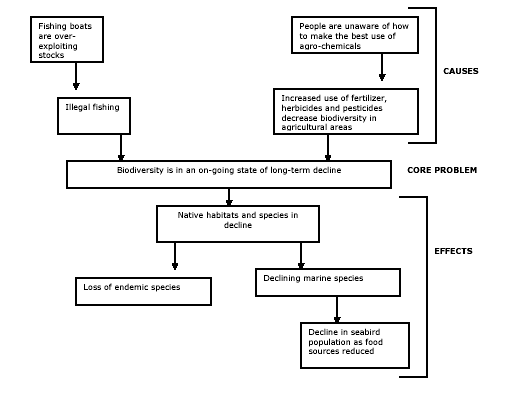Problem Definition
The first task is to define the problem or problems that need to be addressed. If the problem is very complex it might be necessary to break it down into several smaller problems so that each can be addressed more easily. For example, to conserve a wetland ecosystem while facilitating its sustainable use, it might be necessary to address i. ecological degradation resulting from unsustainable use of wetland resources, and ii. community well-being such as health, education, food security, and cultural values.
In some cases the problems may not be related to a practical management activity. For example, encouraging the adoption of the ecosystem approach into national and regional legislation or policies. In these circumstances an analysis of the potential policy outcomes can be assessed against the ecosystem approach principles as a way of determining what actions are necessary.
Whatever the issue at hand the use of tools such as decision and problem trees can be extremely useful. These can be used to understand what issues need to be addressed and the linkages between them, see Figure One
The problem tree below illustrates how the decline of biodiversity within a particular area might be a product of several other problems.

Figure one - Example of a problem tree
Having identified the issues, the next step is to ascertain what tasks would allow the problem to be addressed. At this point it will be necessary to have identified the problem and to have broken it down into smaller units if it covers a range of issues. The problem can be assessed against the tasks listed below as an initial step towards identifying a plan of action. This process can be used to prioritise the actions to be undertaken.
The tasks below have been drawn from the principles of the ecosystem approach. In each case the ecosystem approach principle has been rephrased into a question which can be asked in relation to the problem(s) being addressed. After each question there is information which explains why considering certain actions would lead to potentially beneficial outcomes (taken from UNEP/CBD/SBSTTA/9/INF/4). The tasks are not listed in order of importance they should be addressed in a way which best fits the problem.
It is important to remember that whilst there is no single correct way to implement the ecosystem approach, it should be stressed that all the tasks listed below need to be considered together, and appropriate weight given to each, according to individual circumstances. This means that it might sometimes appear that some tasks have higher priority than others, and some may not be regarded as essential to the issue being addressed. When a particular task is not thought to be important for addressing an issue a reason for this should be assigned so as to understand why that decision was taken – this can become a useful tool when evaluating the project outcomes at a later date. Throughout the life of the project it might also be necessary to revisit the tasks to check whether other actions could be taken to address emerging issues.
Often an activity will address more than one task (and therefore more than one ecosystem approach principle). For example, involving stakeholders in decision making processes would meet the following tasks
- Task 1 Involving all members of society in decisions associated with the management of land, water and living resources
- Task 2 Ensuring management is decentralised to the lowest appropriate level
- Task 4 Ensuring the economic context can be understood
- Task 6 Considering what measures can be taken to ensure ecosystems are managed within the limits of their functioning
- Task 9 Using adaptive management to address the problem(s) identified
- Task 10 Seeking an appropriate balance between, and integration of, conservation and use of biological diversity
- Task 11 Ensuring all forms of relevant knowledge including, scientific, indigenous and local knowledge, innovations and practices are included
- Task 12 Facilitating the involvement of all stakeholders including all sectors of society and scientific disciplines
Under each Task there is a list of tools which can be used to meet the actions required. Further information on
the tools can be found within the Ecosystem Approach Sourcebook, for many there is a link from the tool to guidance on its use. You can also
add tools to the sourcebook to share with others your experiences and methods.
At the end of Section Three a table has been developed to help with the application of the ecosystem approach to a particular project. This can be used by project managers to determine if their project meets all twelve tasks, and if not the reasons why this was the case.